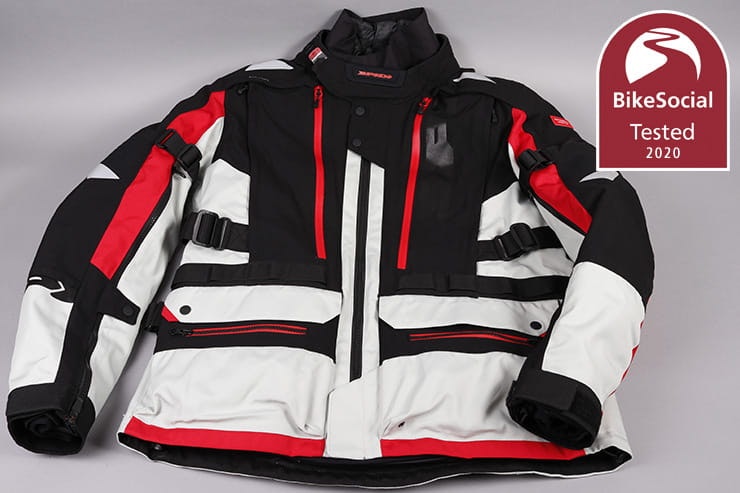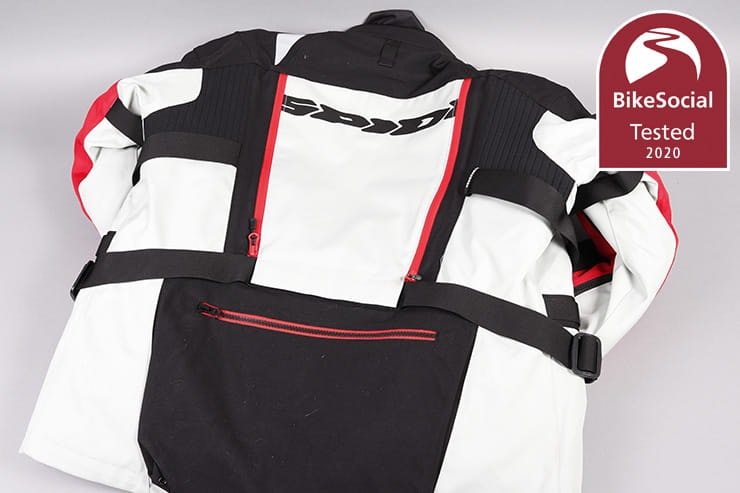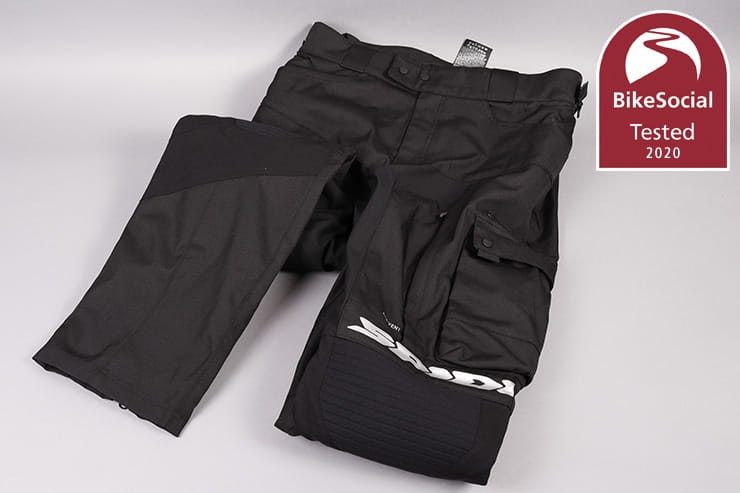Tested: Spidi All Road textile motorcycle jacket and trousers review
By Dave Yorke
Freelance journalist
30.09.2020
Date reviewed: September 2020 | Tested by: Dave Yorke | Price: £499.99 (jacket), £329.99 (trousers) | spidiuk.com
The Spidi All Road textile jacket and trousers on review make up a high-end waterproof adventure suit designed for all weathers and, as the name suggests, all roads.
I’ve been testing it on day rides up to around 250 miles, which typically include an element of light off-road work on green lanes in the Lake District. To get to the Lake District lanes it’s been worn on the motorway and fast A roads while riding my Honda Africa Twin.
Excellent ventilation
Totally waterproof when set up for it
Well thought-out design
As with all adventure suits, can be a fiddle to set up for full wet weather use
No pockets when waterproof liner on outside
Very versatile, but like other adventure suits, won’t suit all riders
Fit
The Spidi All Road suit has been designed for use all-year-round and it shows; the attention to detail that should ensure a great fit includes stretch panels on the main jacket just above the elbow and around the back of the shoulder to allow comfort.
There’s a decent quilted inner liner that can be removed for warmer days, along with a waterproof, windproof and breathable layer that can also be taken out and worn as an outer layer.
With that much variability in how you’re going to wear it, it’s important to try it on in all its configurations before you buy, and don’t assume that just because you’re a large or whatever in other jackets you will be the same in this. There are a lot of elements to this suit so it’s essential to get the right fit, but I can say that my sizing came up as normal.
Protection and certification
It’s great to find the jacket and trousers both certified as PPE, with the mid-level AA rating under prEN 17092 – many textile garments are only tested to the lower A level, so while not up there with the toughest materials and quality leather, the Spidi All Road is a confidence-inspiring bit of kit.
The jacket includes ‘Warrior Lite’ armour rated to EN1221-1 Level 2 in the shoulders and elbows, while the same is fitted in the knees and hips of the trousers. It’s a shame there’s no back-protector fitted, though there is space for one, as well as a chest protector if you want it.
3M Scotchlite reflective material is used on the jacket and trousers, as well as the waterproof liner, which is a very thoughtful touch when riding in foul weather.
From April 21 2018, all new motorcycle clothing is deemed to be Personal Protective Equipment (PPE). To meet this legislation, it must be tested to a recognised standard. For more information on the law, click here.
Pockets
The jacket has two large main pockets on the lower front, which are properly waterproof. Because I’m reviewing whatever jacket I’m wearing, I’ll tend to keep the labels and instructions in the pockets for reference, and to stop myself losing them; all of these have remained dry and in perfect condition, despite riding in downpours, even without the liner on the outside.
There’s a smaller pocket built onto the outside of each of the big pockets and a wallet type pocket built into chest area on the inside. The pockets are either closed with YKK Zips or, in the case of the large ones, fold-over and press studs. All are easily accessible until you put the waterproof part on the outside of the jacket, where there aren’t any pockets.
The main jacket also has loops to attach items or a carabiner to, and there’s the option to fit a hydration system, though unlike some other jackets, this fits to the outside, rather than in a pocket, to ensure maximum airflow through the back panel. There’s a map pocket on the lower back, and another on the left breast behind the main zip.
The trousers feature two open jeans-style pockets on the fronts along with a popper-fastened cargo-type pocket on each leg, one of which has a smaller zipped pocket combined on top.
Fastening
A YKK zip runs up the front of the main jacket, while the inner (or outer, depending how you wear it) breathable waterproof layer has a sealed zip to stop water ingress. The quilted layer also has a YKK zip.
The neck on the main jacket has what Spidi calls EST control – Ergonomic Safety Tuning. It sounds fancy, but popper stud to secure collar is on a patch that’s held on with hook-and-loop, so you can adjust its position. In practice, once you’ve found you’re preferred fit there’s no need to constantly pull apart the hook and loop. Simple and elaborately named, but nonetheless effective.
The trousers have two press studs at the waist, and the jacket and trousers zip together, but although it’s a decent length, the zip doesn’t extend right around to the front, stopping instead at the sides of the hips.
Adjustment
Quilted layer in or not? Waterproof layer inside or out? There’s a lot of different ways you can choose to wear the Spidi All Road, but placing the layers in your desired order isn’t as simple as it seems. It’s not just a case of wearing it in a different order as there are a myriad of loops to attach the waterproof layer to the inside of the jacket, and then a series of press-studs to either keep the inner layer in short format for inside, or in long format if you’re wearing it outside.
The sleeves of the waterproof layer loop through the outer jacket through a small slit and then attach via hook and loop, so once in place it’s all very secure.
The main jacket has an adjustable waist by way of drawcord, and further adjustability around the midriff using adjustable straps. The sleeves adjust to size using both straps and press studs. There was enough room in the jacket when I was wearing all three layers together to wear a shorty glove as normal, and a winter glove with gauntlet both underneath and over the cuffs. Impressive.
The trousers have long zips at the rear – way up to the knees – and it’s super-easy to get a large adventure style boot inside the leg. Fine adjustment on the waist is ensured by way of a hook and loop panel on both sides.
Ventilation
The Spidi All Road jacket has two large ventilation panels on the front and one large one on the back.
The two on the front are opened by a mixture of sealed and conventional zips, although the conventional ones are behind a layer of fabric. There’s hook and loop at the top and it’s possible to just open a zip and leave the panel in place or roll it all down and expose a large front vent on either side of the chest area.
The rear panel is similar and, once open, it exposes a huge vented area. The sleeves have zips from the cuff up to past the elbows, which can be opened for even more air (this is a very effective location to have vents).
Opening the vents makes a real difference and there was noticeable change in airflow on a hot day. While riding through off-road tracks in the lake District I also felt comfortable enough with the breathable rain proof inner in place.
The trousers have a single zip opening on each leg, which opened up to a generous 11 inches in length on the XL size I was wearing.
It’s important to stress that the advantage of a removable waterproof liner is that the ventilation can go straight to the body, making kit like this very effective in hot climates. A normal textile suit with a waterproof drop-liner (the membrane attached inside), will not allow air to blast directly onto the body, so while a well-designed jacket will still keep air moving, this really is the most effective method.
A laminated textile jacket with the membrane bonded to the outer material can have zips that open to allow the air to blast straight through, but they still need some protection as no zip is truly waterproof.
Warmth
The Spidi’s inner quilted layer makes the jacket really snug; on its own you could wear it around a campsite or into town after a long day’s touring, but put together with all the other layers it’s an incredibly warm piece of kit. The trousers, however, don’t come with a quilted liner, so in colder weather you’ll need to consider some long-johns.
Liner
Without everything else installed, the main jacket and the trousers have a comfortable mesh liner that helps air to move around and reduces the chance of your sweaty flesh sticking to it.
Waterproofing
Any riding kit will have its compromises, and while this is an all-weather suit, it might not be the right choice for everyone.
The removable waterproof, breathable and windproof liner can be either worn inside the suit on showery days or outside on really rainy days.
On a day warm day when I removed the waterproof lining and wore the suit without it, it only took an unexpected heavy thunderstorm about five minutes to breach the zip on the sleeve around the bend in my elbow. The jacket dried out quickly on the ensuing run from Hawes to Ingleton though, and that was it as far as getting wet went. There isn’t a storm collar, but the neck of the liner is fairly high.
When I wore the waterproof layer on the outside in continual rain for over three hours it didn’t let a drop in and I didn’t feel hot, despite the humidity that arrives on rainy summer days. What’s more there wasn’t any wicking up of rain, especially around the front of the waist; there wasn’t any ingress anywhere. That is very, very impressive.
The waterproof liner is effective then, and you could leave it inside the jacket for easier access to pockets etc, but the outer material will soon wet out, which will take a long time to dry out when you stop, and will reduce the breathability of the liner, making you feel wet due to sweat.
This is a common compromise on all adventure-focussed garments, which can give great ventilation, but aren’t necessarily the perfect choice for all year-round daily commuters, who often want something quick and easy to throw on. In that case, consider laminated textile kit, though remember it doesn’t offer anything like the same level of venting for hotter weather.
Spidi All Road motorcycle textiles review: Verdict
As a suit for all-year-round riding the Spidi All Road is very capable. When used correctly it’s warm and waterproof, as well as protective, but on days when the weather’s a bit changeable it can be something of a pain deciding how to wear it and then adapting it to suit.
Having said that, on days when you know what the forecast is ahead, it’s easy to plan how to set it up.
It’s obvious that an awful lot of thought has gone into the Spidi All Road to ensure that all of the layers fit together well and adjust to the different conditions it can be worn in, so if you think an adventure suit like this would work for your riding circumstances, it’s well worth considering.


